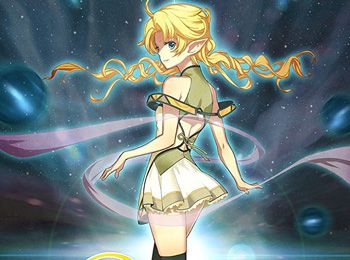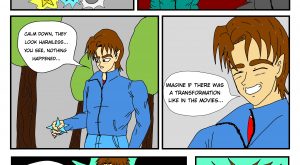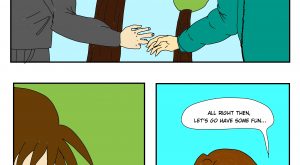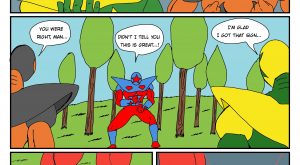YU-NO: A Girl Who Chants Love at the Bound of this World (manga/game)
YU-NO: A Girl Who Chants Love at the Bound of this World is a visual novel adventure game developed and published by ELF Corporation. It was originally released in 1996 as an eroge for the NEC PC-98 Japanese home computer and later ported to the Sega Saturn and Microsoft Windows platforms without the sexual content. The story follows the protagonist travelling between parallel worlds to solve the mystery of his parents’ disappearance. The game uses concepts from science fiction, physics, mathematics, philosophy, history and religion to construct a unique fictional universe. The “Auto Diverge Mapping System” (A.D.M.S.) that displays the branching parallel worlds and storylines as a tree helps the player navigate the game world.
YU-NO was written and produced by Hiroyuki Kanno, and its FM-synth music soundtrack was composed by Ryu Umemoto, Ryu Takami and Kazuhiro Kanae, who had previously worked on C’s Ware titles such as Eve Burst Error (1995). YU-NO was well-received and influential in Japan, where it revolutionized the visual novel industry and in turn had an impact on the manga and anime industries, inspiring numerous visual novel, manga and anime works.
In 2017, 5pb. (Later Mages) developed and published a remake of the game for the PlayStation Vita and PlayStation 4. Spike Chunsoft released this version for PlayStation 4, Microsoft Windows, and Nintendo Switch in 2019. The game has also been adapted into a four-part hentai original video animation, a manga and novels, and a TV anime series by Feel that aired from April to October 2019. The TV anime series is licensed by Funimation and Crunchyroll outside Japan.
Title
The bound of this world (この世の果て, kono yo no hate) referred to in the title is the location the protagonist reaches at the conclusion of the game. Yu-no is the name of a girl central to the story. The creators said “YU-NO”, which comes last word in the Japanese title, is meant to be a subtitle. The English version of the title that is used in some artwork is stylized as “YU-NO: A girl who chants love at the bound of this world.”, with a period. A connection to Harlan Ellison‘s short story The Beast that Shouted Love at the Heart of the World has been noted by Robert Allen of Tech-Gaming.
Gameplay
The PC-98 and Sega Saturn versions of the game are slightly different. Unless otherwise noted, the following information describes the PC-98 version.
Players travel between parallel worlds using a reflector device that uses stones to mark positions as returning locations so they can retrace their steps and enter an alternative universe. The game implements an original system called Automatic Diverge Mapping System (A.D.M.S.) that at any time in the game displays a screen showing the direction in which the player was heading along the branching plot lines. Similar systems have later been used in the 2010 role-playing video game Radiant Historia and the PSP version of Tactics Ogre: Let Us Cling Together.
Prologue
The game begins with a linear prologue which introduces the setting and characters, taking place during a couple of days. The player controls Takuya Arima, a student in the fictional Japanese city Sakaimachi. Takuya had a frictive relationship with his historian father Koudai Arima, who has been declared dead after having disappeared months prior. Takuya barely remembers his biological mother Keiko Arima who had died when he was very young, and he now lives with his stepmother Ayumi Arima. Ayumi is still grieving the loss of Koudai after only six months of marriage and is increasingly busy with work. Eriko Takeda is Takuya’s new homeroom teacher and school nurse from abroad; she has become addicted to smoking and, unfamiliar with Japanese standards, took up Takuya’s advice to dress skimpily. He meets Koudai’s research partner and Sakaimachi Academy’s headmaster Kouzou Ryuuzouji, who requests Koudai’s belongings. His secretary is Mitsuki Ichijou, a former teacher and lover of Takuya. Some other students at Takuya’s school include recent transfer student Kanna Hatano, the mayor’s daughter Mio Shimazu, and Masakatsu Yuuki. Takuya meets Ayumi’s underling Hideo Toyotomi, whom he takes an instant disliking to.
On a nearby beach, there is a tower-like rock formation going by the names Sword Cape and Triangle Mountain, at the foot of which stand two rocks dated as 8000 years old with unknown, 400 years old writing on them. Geo Technics, the company Ayumi works for, is occupying the beach as a construction survey site, but the workers are constantly injured by inexplicable lightning strikes. Kanna habitually warns people to stay away from the area.
One evening Takuya receives a package containing an incomplete letter from Koudai and a small otherworldly device with several slots, some fitted with round jewels. The letter talks about Koudai’s theory of history and multiple timelines, tells that Koudai has departed elsewhere rather than having died, that the device (known as the Reflector Device) can be used to turn back time, and that Takuya should find the missing jewels and afterwards come to Sword Cape 10 PM that night to meet somebody. Takuya arrives (without all the jewels) and encounters there a naked blonde woman, who upon awakening kisses him, dies and vanishes from existence. Ryuuzouji and Ayumi arrive; Ryuuzouji demands at gunpoint Takuya to hand over the Reflector Device, but a sudden spacetime distortion shifts Takuya to an alternate timeline where he’s alone at Sword Cape.
Epilogue
Once all jewels are collected, Takuya can enter Triangle Mountain during the correct time. A device there transports him to another world and he loses the Reflector Device. He wakes up confused in a forest and meets a mute blonde pointy-eared girl whose name he deduces as Sayless. The forest is isolated by a cliff beyond which nothing but clouds are visible, and a huge desert. They find the house of a sick knight named Illia, who tells him that the world is Dela Grante; that its inhabitants have pointy ears (like Sayless and Illia); that she is guarding it from monsters arriving from beyond the cliff, known as The Border; that every 400 years a priestess prevents an apocalypse by inhibiting a bodily function to allow “God” within her and being killed in a ritual in a city known as the Capital; that Sayless is an escaped such priestess despite recent earthquakes signifying the current apocalypse; and that Illia has a sister with no faith in Dela Grante’s religion. Illia is then fatally injured when protecting Sayless from a monster.
Takuya can’t cross the desert, but eventually his frustration and homesickness give way to love towards Sayless, and the two begin a happy life in Illia’s house. A baby girl, Yu-no, is born to them, and grows within only four years to a teenager-like appearance. One day a dying member of nogards, a species of winged humanoids, arrives and entrusts them with her lizard-form infant, named Kun-kun by Yu-no.
Their idyllic life is interrupted as they’re invaded by knights from the Capital, and Sayless commits suicide upon capture. Takuya swears revenge on the God Emperor, ruler of Dela Grante residing in the Capital. Leaving Kun-kun behind, Takuya and Yu-no barely cross the desert; however, they are arrested for trespassing a temple and are separated. Takuya ends up working for months in a quarry where enslaved prisoners mine Hypersense Stones for a casket required for the priestess ritual. A machine tower like the one inside Sword Cape uses lightning to kill any slave attempting to escape. Takuya befriends another prisoner, Amanda, who resembles Kanna’s mother; she is the leader of a rebel faction believing that the apocalypse and ritual are a lie by the God Emperor to keep the people in control. An earthquake destroys the quarry, leaving as the only survivors Takuya, Amanda, and the now adult Kun-kun who saves them by flying. They head for the Capital, and along the way Kun-kun becomes exhausted from carrying the other two across the desert and is eaten by them, Amanda is saddened upon learning of her sister Illia’s death and has sex with Takuya, and they find a Reflector Device at a temple.
Once in the Capital, Takuya encounters a new priestess commanding troops and escapes from her into the sewers, which lead to a prison beneath the Emperor’s palace. There he meets an imprisoned Ryuuzouji, who reveals that the latest priestess lost her mind as a bodily function to give up, making Takuya realise the current priestess is a brainwashed Yu-no. Takuya frees him in exchange for the information and sneaks into the palace where he cures Yu-no back to normal using Ryuuzouji’s advice. Several reveals follow: The God Emperor is actually the Ayumi from the prologue, and was transported alongside Ryuuzouji to Dela Grante by the spacetime distortion; her intentions are good as the ritual is genuine; Dela Grante was constructed 8000 years earlier by a scientifically advanced race as a place to escape an impending apocalypse on Earth; Dela Grante is in an unstable interdimensional orbit around Earth and the ritual is needed every 400 years to avoid a catastrophic collision between the worlds – the computerised mind of ancient head scientist Grantia inhabits a priestess’ body to steer Dela Grante, after which the priestess is ejected from the dimension and likely dies; each 400 years the worlds were also so close that some people crossed them, including previous priestess Keiko, explaining the Celestials; the race genetically modified people to have short childhoods and long lifespans but they became dependent on Hypersense Stones; they made other species to survive Dela Grante and discarded failed specimens beyond the Border; later generations couldn’t understand the technology and interpreted it religiously; Eriko, who is an interdimensional investigator named Äichli:kkwádroú from yet another world, appears (later explaining smoking was foreign to her world and that she slept on the floor as a remedy for interdimensional travel); Ryuuzouji’s body has been possessed the whole time by an entity, which is pursued by Eriko for effectively killing her lover by possessing him and had then arrived at Ryuuzouji’s using the interdimensional vehicle. The night before the ritual, Yu-no pleads to have sex with Takuya, who reluctantly complies.
The entity attempts to prevent the ritual because it’d survive the annihilation of the worlds and so escape Eriko, but is defeated – after expelling Amanda into another dimension (said to possibly end up on Earth) with a 50 year maximum time difference, and mortally wounding Ayumi. Earth is saved thanks to Yu-no, but Dela Grante inevitably meets its end by colliding on Earth 8000 years in the past, and Yu-no is thrust out of Dela Grante’s dimension. With the Reflector Device, and a jewel he gave her, Takuya returns to the moment at Sword Cape where he first saw Yu-no, who was the naked woman in the prologue. The two then begin drifting in a void between dimensions to the beginning of time.
Releases
PC-98
YU-NO was released as an adult game on December 26, 1996, for the NEC PC-98; it was the last MS-DOS-based game developed by ELF. The price at the time was 9800 yen. Both floppy disk and CD-ROM versions were released; the CD-ROM edition contained arrangements of the music but was otherwise identical to the floppy edition.
Sega Saturn
YU-NO was released on the Sega Saturn console on December 4, 1997 with a recommended minimum age of 18. The price was 7800 yen, or 9800 yen bundled with a mouse. Several illustrations underneath the CD tray can only be seen after opening the game. A disk containing extra content that was later mailed out with the PC-98 version was integrated into this version. As in the Windows version, some incest references have been removed. Graphics were repainted to use more colors, animation sequences were added, the music was rearranged, character voices were added, two jewels were added (total of 10) and explicit sex scenes were removed.
Windows
The PC-98 version of the game was ported to Microsoft Windows as part of the “ELF Classics” range and released on December 22, 2000. The graphics and music are equivalent to the PC-98 version but the sexual content was removed.
Fan translation
An English-language fan-made translation patch for the Windows version was released in September 2011 by TLWiki. As well as the translation, it provides re-inserted voices from the Sega Saturn version, explicit sex scenes, Ryu Umemoto’s original FM score and Sega Saturn CGs. Hardcore Gaming 101 praised the patch for the quality of its translation and called it “one of the finest examples of fan efforts in video gaming”.
Remake
A high-definition video remake of the game was released in March 2017. It was developed by 5pb., which acquired the rights from the now-defunct ELF. It features a remixed soundtrack and new artwork redone in a different style, with Ryo Nagi of Ar Tonelico as character designer. The decision for a new art style was made because something easier to depict in animated form was wanted, with the 2019 anime adaptation already in mind. The remake was announced in December 2014 and its release date was delayed several times – first to February 2016, then to the second quarter of 2016, then late 2016 and finally to March 2017.
An English localization was released by Spike Chunsoft on October 1, 2019 worldwide for Microsoft Windows, and in North America for Nintendo Switch and PlayStation 4; the game was released in European markets on October 4, 2019. The Switch Day 1 Edition included a side-scrolling shooting game called 8-BIT YU-NO’s Great Adventure.
Music
In 1997 came out both Super Soundtrack and Original Sound & Voice Collection soundtrack releases; in 2016 an album titled Tribute to Ryu Umemoto: Music from YU-NO featuring remixes by video game composers such as Hiroki Kikuta, Yuji Takenouchi, and Ippo Yamada; and in 2017 alongside the remake a 5-disc collection clocking at 15 hours containing, in addition to the albums from 1997, also recordings of the original PC-98 and remake soundtracks.
In 2011, the music of YU-NO inspired an eroge tribute music album named Tree of Knowledge. RPGFan said in 2022 that composer Ryu Umemoto’s reputation has grown posthumously and praised the 5-disc collection as “must-have for fans of Umemoto, fans of YU-NO, fans of visual novels, and fans of VGM in general”.
Anime
Pink Pineapple produced and released a four-episode hentai anime original video animation series during 1998–1999. The anime had multiple changes from the original game such as cutting multiple characters and adding characters from the A.D.M.S. section into the Epilogue.
A new, 26-episode anime adaptation began airing on April 2, 2019 for half a year. Announced in 2016, it was produced by Feel in collaboration with MAGES and Genco and was broadcast on AT-X, Tokyo MX, ABC, and BS Fuji, with Crunchyroll and Funimation streaming outside Japan with an additional English dub. The anime is directed by Tetsuo Hirakawa, and the characters are designed by Mai Otsuka. Kazuya Tanaka is the sound director, and Keishi Yonao and Ryu Takami were assigned to compose the series’ music. Asaka performed the series’ opening theme song Kono Yo no Hate de Koi o Utau Shojo (この世の果てで恋を唄う少女, Kono Yo no Hate de Koi o Utau Shōjo), while Konomi Suzuki performed the series’ ending theme song Shinri no Kagami, Tsurugi no Yō ni (真理の鏡、剣乃ように, Shinri no Kagami, Tsurugi no Yō ni) Suzuki performed the series’ second opening theme song “MOTHER”, while Asaka performed the series’ second ending theme song Kami no Sūshiki (神の数式, Kami no Sūshiki).
Hirakawa said the anime would include all characters and routes from the original game. Unlike the game’s first-person perspective from protagonist Takuya’s point of view, the anime was declared to depict the relationships of the girls surrounding Takuya. Hirakawa also said the anime would “outdo the game in dirty jokes”, that Mio would “be even more tsundere“, and that Kanna would “be even more mysterious”.
A new episode was bundled with the series’ third Blu-ray volume on December 26, 2019.
Manga
A manga adaptation by Mario Kaneda was published in Enix‘s G Fantasy magazine from 1997 to 1998. A manga adaptation by Sōji Ishida ran in Enterbrain‘s Comic Clear magazine from March 14, 2017 to March 15, 2018.
| YU-NO: A Girl Who Chants Love at the Bound of this World | |

NEC PC-98 cover
|
|
| この世の果てで恋を唄う少女YU-NO (Kono Yo no Hate de Koi o Utau Shōjo YU-NO) |
|
|---|---|
| Genre | Science fiction |
| Game | |
| Developer | ELF Corporation (original) 5pb. (remake) |
| Publisher | Original ELF Corporation Remake
EU: Numskull Games |
| Produced by | Remake Makoto Asada Chiyomaru Shikura |
| Designed by | Hiroyuki Kanno |
| Music by | Ryu Umemoto Ryu Takami Kazuhiro Kanae (original) Keishi Yonao (remake) |
| Genre | Adventure game, visual novel |
| Platform | Original NEC PC-98, Sega Saturn, Microsoft Windows Remake PlayStation Vita, PlayStation 4, Nintendo Switch, Microsoft Windows |
| Released |
show
December 26, 1996
|
| Manga | |
| Written by | Mario Kaneda |
| Magazine | G Fantasy |
| Demographic | Shōnen |
| Original run | 1997 – 1998 |
| Original video animation | |
| YU-NO | |
| Directed by | Katsuma Kanazawa Yagoshi Mamoru |
| Written by | Osamu Kudo Sakura Momoi |
| Studio | Pink Pineapple |
| Licensed by | |
| Released | October 23, 1998 – September 24, 1999 |
| Episodes | 4 |
| Manga | |
| Written by | Sōji Ishida |
| Published by | Enterbrain |
| Magazine | Comic Clear |
| Demographic | Seinen |
| Original run | March 14, 2017 – March 15, 2018 |
| Volumes | 2 |
| Anime television series | |
| Directed by | Tetsuo Hirakawa |
| Produced by |
|
| Written by |
|
| Music by |
|
| Studio | Feel |
| Licensed by | |
| Original network | AT-X, Tokyo MX, ABC, BS Fuji |
| Original run | April 2, 2019 – October 1, 2019 |
| Episodes | 26 + OVA |






